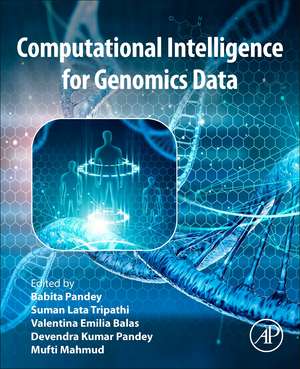Computational Intelligence for Genomics Data: Advances in Biomedical Informatics
Editat de Babita Pandey, Valentina Emilia Balas, Suman Lata Tripathi, Devendra Kumar Pandey, Mufti Mahmuden Limba Engleză Paperback – 22 ian 2025
- Provides comparative analysis of machine learning and deep learning methods in the analysis of genomic data, discussing major design challenges, best practices, pitfalls, and research potential
- Explores machine and deep learning techniques applied to dimensionality reduction, feature extraction, data selection, and their application in genomics
- Presents case studies of various diseases based on gene microarray expression data, including cancer, liver disorders, neuromuscular disorders, and neurodegenerative disorders
Preț: 798.72 lei
Preț vechi: 1185.78 lei
-33% Nou
Puncte Express: 1198
Preț estimativ în valută:
152.83€ • 166.54$ • 128.79£
152.83€ • 166.54$ • 128.79£
Carte tipărită la comandă
Livrare economică 16-30 aprilie
Preluare comenzi: 021 569.72.76
Specificații
ISBN-13: 9780443300806
ISBN-10: 0443300801
Pagini: 328
Dimensiuni: 216 x 276 mm
Greutate: 0.9 kg
Editura: ELSEVIER SCIENCE
Seria Advances in Biomedical Informatics
ISBN-10: 0443300801
Pagini: 328
Dimensiuni: 216 x 276 mm
Greutate: 0.9 kg
Editura: ELSEVIER SCIENCE
Seria Advances in Biomedical Informatics
Cuprins
Section 1: Introduction to biological data and analysis
1.1 Genomic data
1.2 Microarray analysis
1.3 Hub gene selection
1.4 Pathogenesis
1.5 Expressive gene
1.6 Gene reduction
1.7 Biomarkers
Section 2: Traditional Machine learning models for gene selection and classification
2.1 Gene selection and liver disease classification using machine learning
2.2 Gene selection and Diabetic kidney disease classification using machine learning
2.3. Gene selection and neurodegenerative disease classification using machine learning
2.4. Gene selection and neuromuscular disorder classification using machine learning
2.5. Gene selection and cancer classification using machine learning
2.6. Gene selection and disease classification using machine learning
Section3: Deep learning models for gene selection and classification
3.1 Gene selection and liver disease classification using deep learning
3.2 Gene selection and Diabetic kidney disease classification using machine learning
3.3. Gene selection and neurodegenerative disease classification using deep learning
3.4. Gene selection and neuromuscular disorder classification using deep learning
3.5. Gene selection and cancer classification using deep learning
3.6. Gene selection and disease classification using deep learning
Section 4: Gene selection and classification using Artificial intelligence-based optimization methods
4.1 Gene selection and liver disease classification using Particle warm optimization, genetic algorithm, principal component analysis, wolf optimization, ant colony optimization etc.
4.2 Gene selection and Diabetic kidney disease classification using Particle warm optimization, genetic algorithm, principal component analysis, wolf optimization, ant colony optimization etc.
4.3. Gene selection and neurodegenerative disease classification using Particle warm optimization, genetic algorithm, principal component analysis, wolf optimization, ant colony optimization etc.
4.4. Gene selection and neuromuscular disorder classification using Particle warm optimization, genetic algorithm, principal component analysis, wolf optimization, ant colony optimization etc.
4.5 Gene selection and cancer classification using Particle warm optimization, genetic algorithm, principal component analysis, wolf optimization, ant colony optimization etc.
Section 5: Explainable AI for computational biology
5.1. Use of LIME for diagnosis of disease
5.2. Use of Shape for diagnosis of disease
5.3. Quantitative graph theory for integrated omics data
Section 6: Applications of computational biology in healthcare
6.1 Diagnosis of liver disorder
6.2 Diagnosis of diabetic kidney disease
6.3 Diagnosis of cancer
6.4 Diagnosis of neurodegenerative disorder.
6.5 Diagnosis of neuromuscular disorder
6.6. Diagnosis of any other health disorder
1.1 Genomic data
1.2 Microarray analysis
1.3 Hub gene selection
1.4 Pathogenesis
1.5 Expressive gene
1.6 Gene reduction
1.7 Biomarkers
Section 2: Traditional Machine learning models for gene selection and classification
2.1 Gene selection and liver disease classification using machine learning
2.2 Gene selection and Diabetic kidney disease classification using machine learning
2.3. Gene selection and neurodegenerative disease classification using machine learning
2.4. Gene selection and neuromuscular disorder classification using machine learning
2.5. Gene selection and cancer classification using machine learning
2.6. Gene selection and disease classification using machine learning
Section3: Deep learning models for gene selection and classification
3.1 Gene selection and liver disease classification using deep learning
3.2 Gene selection and Diabetic kidney disease classification using machine learning
3.3. Gene selection and neurodegenerative disease classification using deep learning
3.4. Gene selection and neuromuscular disorder classification using deep learning
3.5. Gene selection and cancer classification using deep learning
3.6. Gene selection and disease classification using deep learning
Section 4: Gene selection and classification using Artificial intelligence-based optimization methods
4.1 Gene selection and liver disease classification using Particle warm optimization, genetic algorithm, principal component analysis, wolf optimization, ant colony optimization etc.
4.2 Gene selection and Diabetic kidney disease classification using Particle warm optimization, genetic algorithm, principal component analysis, wolf optimization, ant colony optimization etc.
4.3. Gene selection and neurodegenerative disease classification using Particle warm optimization, genetic algorithm, principal component analysis, wolf optimization, ant colony optimization etc.
4.4. Gene selection and neuromuscular disorder classification using Particle warm optimization, genetic algorithm, principal component analysis, wolf optimization, ant colony optimization etc.
4.5 Gene selection and cancer classification using Particle warm optimization, genetic algorithm, principal component analysis, wolf optimization, ant colony optimization etc.
Section 5: Explainable AI for computational biology
5.1. Use of LIME for diagnosis of disease
5.2. Use of Shape for diagnosis of disease
5.3. Quantitative graph theory for integrated omics data
Section 6: Applications of computational biology in healthcare
6.1 Diagnosis of liver disorder
6.2 Diagnosis of diabetic kidney disease
6.3 Diagnosis of cancer
6.4 Diagnosis of neurodegenerative disorder.
6.5 Diagnosis of neuromuscular disorder
6.6. Diagnosis of any other health disorder

